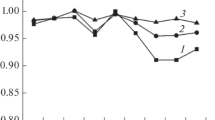Conclusions
1. The heating of polymer surfaces associated with vacuum metal deposition is determined by the deposition rate and the deposition time and also by the thermo-physical characteristics of the substrate—growing film system, and at high deposition rates may reach the phase-transition temperatures of the polymers.
2. At deposition rates up to 5 Å/sec the rise in surface temperature can be calculated by solving the usual heat-conduction equation, and at higher rates by solving the nonstationary heat-conduction equation, which makes it possible to take into account the heat transfer characteristics of the substrate— growing film system.
3. The temperature of the polymer condensation surface can be regulated by varying the initial substrate temperature and, moreover, by using the pulsed metal vaporization process.
Similar content being viewed by others
Literature cited
L. Holland, Vacuum Deposition of Thin Films, Wiley, New York (1956).
L. S. Palatnik and Yu. F. Komnik, "Mechanism of condensation of metals in a vacuum," Dokl. Akad. Nauk SSSR,124, No. 4, 808–811 (1959).
V. P. Severdenko and E. I. Tochitskii, Structure of Thin Metal Films [in Russian], Minsk (1968).
A. M. Krasovskii and N. S. Gorbach, "Investigation of the process of condensation of low-melting metal vapors on glass surfaces at low temperatures," Dokl. Akad. Nauk. BelorusSSR,18, No. 4, 337–339 (1974).
A. M. Krasovskii and V. A. Belyi, "Nucleation kinetics of metallic condensates on polymer surfaces at low temperatures," Dokl. Akad. Nauk BelorusSSR,19, No. 4, 334–336 (1975).
D. Nakai and M. Takakhasi, "Rise in substrate surface temperature during vacuum deposition and time variation of the strength of germanium films," Oe Butsuri, 32, No. 1, 17–23 (1963) [Russian translation No. 38664/4, Moscow, Translations Bureau, VINITI].
V. N. Petrosyan and E. I. Dagman, "Epitaxial crystallization under vacuum at high super-saturations," in: Problem of Epitaxy of Semiconductor Films [in Russian], Novosibirsk (1972), pp. 136–194.
Yu. F. Komnik, "Thermal effects in the initial stage of condensation of molecular beams," in: Dispersed Metal Films [in Russian], Kiev (1972), pp. 99–106.
G. Breitweiser and B. N. Varadarajan, "Influence of film condensation and source radiation on substrate temperature," J. Vac. Sci. Technol.,7, No. 1, 274–277 (1970).
J. C. D. Brand and G. Eglinton, Applications of Spectroscopy to Organic Chemistry, Davey.
Additional information
Institute of Mechanics of Metal—Polymer Systems, Academy of Sciences of the Belorussian SSR, Gomel'. Translated from Mekhanika Polimerov, No. 1, pp. 50–55, January–February, 1977.
Rights and permissions
About this article
Cite this article
Krasovskii, A.M., Palii, O.I. & Rogachev, A.V. Heating of polymer surfaces during the vacuum deposition of metals. Polymer Mechanics 13, 47–51 (1977). https://doi.org/10.1007/BF00857279
Received:
Issue Date:
DOI: https://doi.org/10.1007/BF00857279



